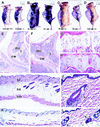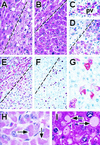Deletion of Ku86 causes early onset of senescence in mice
- PMID: 10485901
- PMCID: PMC17958
- DOI: 10.1073/pnas.96.19.10770
Deletion of Ku86 causes early onset of senescence in mice
Abstract
DNA double-strand breaks formed during the assembly of antigen receptors or after exposure to ionizing radiation are repaired by proteins important for nonhomologous end joining that include Ku86, Ku70, DNA-PK(CS), Xrcc4, and DNA ligase IV. Here we show that ku86-mutant mice, compared with control littermates, prematurely exhibited age-specific changes characteristic of senescence that include osteopenia, atrophic skin, hepatocellular degeneration, hepatocellular inclusions, hepatic hyperplastic foci, and age-specific mortality. Cancer and likely sepsis (indicated by reactive immune responses) partly contributed to age-specific mortality for both cohorts, and both conditions occurred earlier in ku86(-/-) mice. These data indicate that Ku86-dependent chromosomal metabolism is important for determining the onset of age-specific changes characteristic of senescence in mice.
Figures



References
-
- Martin G M. Birth Defects Orig Artic Ser. 1978;14:5–39. - PubMed
-
- Epstein C J, Martin G M, Schultz A L, Motulsky A G. Medicine. 1966;45:177–221. - PubMed
-
- Yu C-E, Oshima J, Fu Y-H, Wijsman E M, Hisama F, Alisch R, Matthews S, Nakura J, Miki T, Ousais S, et al. Science. 1996;272:258–262. - PubMed
-
- Gray M D, Shen J-C, Kamath-Loeb A S, Blank A, Sopher B L, Martin G M, Oshima J, Loeb L A. Nat Genet. 1997;17:100–103. - PubMed
Publication types
MeSH terms
Substances
Grants and funding
LinkOut - more resources
Full Text Sources
Other Literature Sources
Medical
Molecular Biology Databases
Research Materials
Miscellaneous

